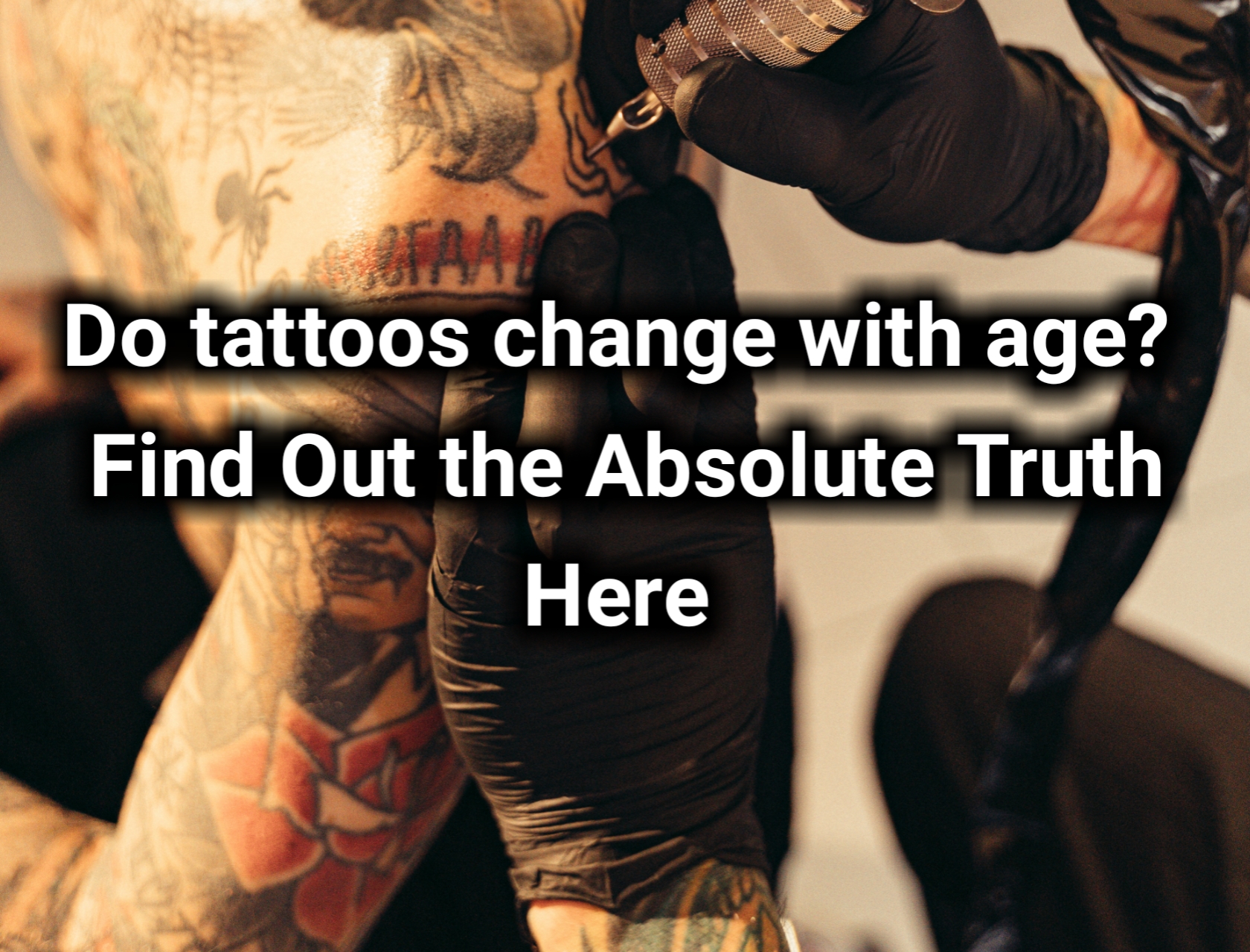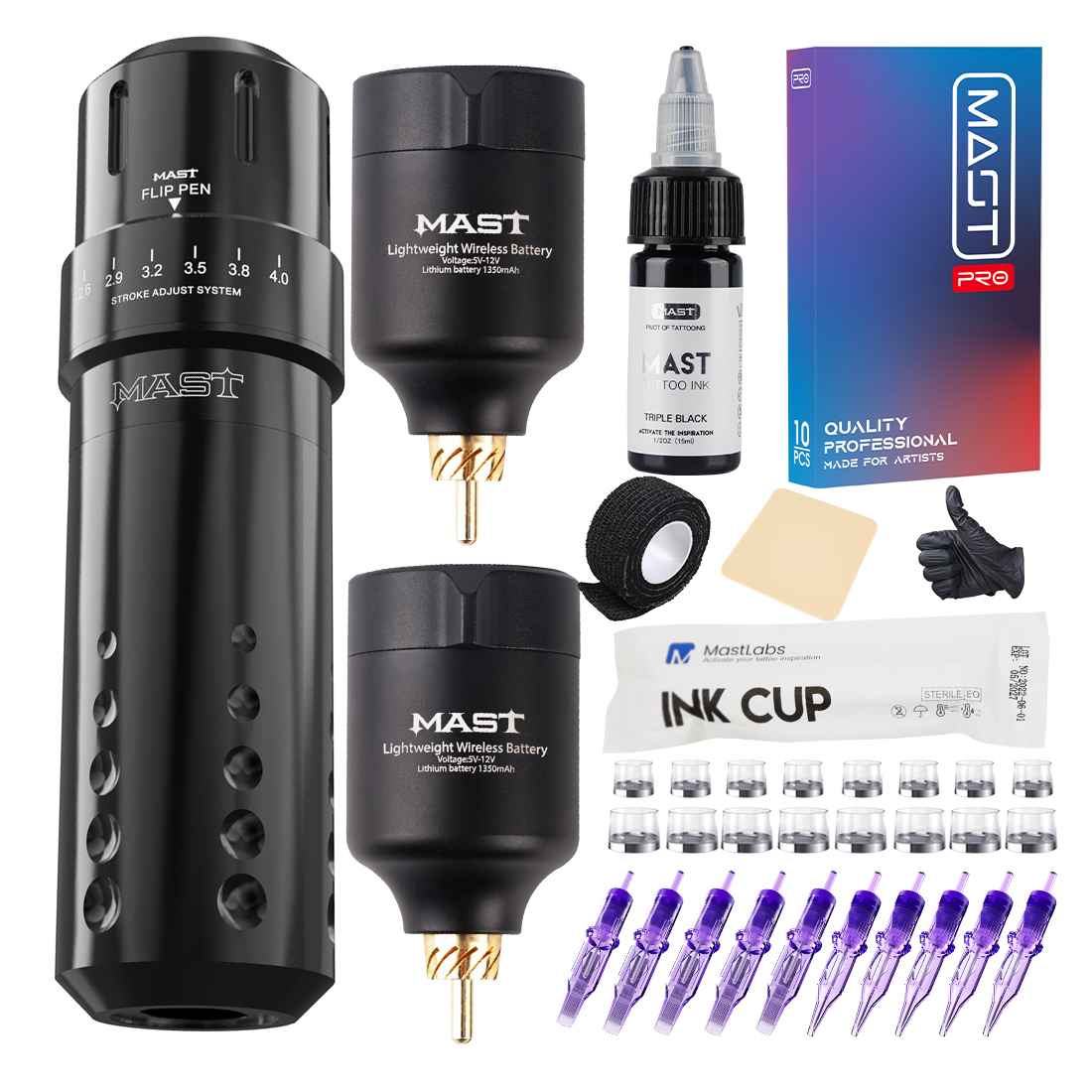Tattoos have been an integral part of human culture for centuries, serving as expressions of personal identity, artistry, and symbolism.
From intricate designs to meaningful quotes, tattoos have adorned the skin of individuals across diverse backgrounds and generations.
However, as time passes and we journey through life, one question arises: Do tattoos change with age?
Understanding the long-term effects of tattoos is of utmost importance for both tattoo enthusiasts and those considering getting inked.
It allows us to appreciate the evolving nature of these body art forms, anticipate potential alterations, and make informed decisions about our own skin canvases.
Tattoos, like many aspects of our physical selves, are subject to transformations as we age.
The once vibrant and pristine inked patterns on our skin may gradually undergo alterations, leading to variations in color, shape, and overall appearance.
While some changes may be imperceptible or even add character to the tattoo, others might cause concern or dissatisfaction.
Exploring the intricate relationship between tattoos and the aging process unravels a fascinating journey where art meets biology.
Factors Affecting Tattoo Aging
Our bodies are constantly changing and evolving as we age, and tattoos are not exempt from the effects of time.
Understanding the factors that contribute to the aging of tattoos is essential for those who want to maintain the integrity and vibrancy of their inked artworks.
1. Skin elasticity and collagen breakdown
The aging process affects not only our overall appearance but also the way tattoos interact with our skin.
One crucial aspect to consider when pondering the question, “Do tattoos change with age?” is the natural decline in skin elasticity and the breakdown of collagen fibers.
These factors play a significant role in how tattoos age and evolve over time.
Let’s see their impact on tattoos;
Impact of aging on skin structure and texture
As we grow older, our skin undergoes a natural aging process that affects its structure and texture.
Over time, our skin loses its elasticity and becomes thinner, making it more prone to sagging and wrinkling. This inevitable decline in skin quality can have a direct impact on the appearance of tattoos.
The once taut canvas on which the tattoo was inked may begin to loosen and develop fine lines, causing the tattoo to appear less sharp and defined.
How collagen loss affects tattoo appearance
Collagen, a protein that provides structural support to the skin, plays a vital role in preserving the integrity and clarity of tattoos.
Unfortunately, as we age, our bodies produce less collagen, leading to a breakdown in the skin’s structural framework.
The gradual loss of collagen can result in the skin becoming thinner and more translucent, which can affect the visibility and vibrancy of tattoos.
As the collagen fibers diminish, the tattoo pigments may spread and diffuse, causing once precise lines and intricate details to blur and merge together.
2. Sun exposure and UV radiation
Our skin’s relationship with the sun can have a profound impact on the long-term appearance of tattoos.
Sun exposure and the damaging effects of ultraviolet (UV) radiation can alter the vibrancy and clarity of tattoos over time.
As we explore the question, “Do tattoos change with age?” it becomes evident that sun damage is a significant factor to consider.
1. Fading and distortion caused by sun damage
The sun’s rays contain UV radiation that can penetrate the skin and interact with the tattoo ink.
Overexposure to the sun’s UV rays can break down the pigments within the tattoo, leading to fading and dullness.
Colors may become muted or appear less vibrant than when the tattoo was freshly inked.
Moreover, the intensity of the sun’s rays can cause the tattoo lines to blur and the design to lose its sharpness and definition.
This can result in a tattoo that appears diffused and less distinct.
2. Importance of sunscreen for preserving tattoo colors
To counteract the damaging effects of the sun, protecting your tattoos with sunscreen is of paramount importance.
Applying a broad-spectrum sunscreen with a high sun protection factor (SPF) to tattooed areas helps shield them from harmful UV radiation.
By creating a barrier between the sun’s rays and the tattoo, sunscreen can minimize the fading and distortion caused by sun damage.
Regular application of sunscreen, particularly when spending prolonged periods outdoors, can help maintain the integrity of the tattoo’s colors and design.
Furthermore, seeking shade, wearing protective clothing that covers the tattooed areas, and utilizing sun-protective accessories like hats and sleeves can provide additional defense against UV radiation.
By incorporating these practices into your daily routine, you can help preserve the vibrancy and clarity of your tattoos as you age.
Also Read: Why do old tattoos spread?
Weight fluctuations and body changes
As we navigate the various stages of life, our physical appearance undergoes transformations influenced by factors such as weight fluctuations and significant body changes.
These changes, in turn, can have an impact on our tattoos, leading to questions about whether tattoos change with age.
Let’s explore two aspects related to this phenomenon:
1. Stretching and distortion of tattoos due to weight gain or loss
Our bodies naturally experience fluctuations in weight throughout different stages of life, whether it be due to hormonal changes, lifestyle factors, or aging itself.
These shifts can potentially affect the appearance of tattoos, particularly if the fluctuations result in significant weight gain or loss.
When the skin stretches or contracts abruptly, as is often the case with rapid weight changes, it can cause the tattoo to distort and lose its original shape.
Fine lines may widen, intricate details may become less discernible, and the overall composition of the tattoo may appear stretched or compressed.
It is essential to recognize that while some degree of elasticity can help the skin bounce back, excessive or repetitive stretching may lead to permanent changes in the tattoo’s appearance.
2. Pregnancy and its effects on tattoos
Pregnancy is a remarkable and transformative journey that brings about numerous physical changes in a woman’s body.
As the abdomen expands to accommodate the growing baby, the skin stretches to accommodate the changes, potentially affecting any tattoos in the area.
The stretching of the skin during pregnancy can cause tattoos located on the abdomen or hips to become distorted or stretched out of shape.
Additionally, hormonal fluctuations during pregnancy can impact the skin’s texture and color, potentially altering the appearance of tattoos.
It is worth noting that these changes are not necessarily permanent, as the skin may regain some of its pre-pregnancy characteristics over time.
Specific Changes in Tattoo Appearance
As we explore the impact of aging on tattoos, it becomes evident that certain changes can alter their overall appearance.
These transformations can range from subtle shifts to more noticeable variations, ultimately contributing to the unique evolution of each tattoo over time.
Understanding these specific changes allows us to appreciate the dynamic nature of tattoos and make informed decisions about their care and maintenance.
Fading and blurring of colors
One of the most common changes observed in aging tattoos is the gradual fading and blurring of colors.
The vibrant hues that once adorned the skin may lose their intensity and clarity, resulting in a less vibrant and more muted appearance.
Several factors contribute to this phenomenon, including the natural breakdown of color pigments within the skin and external factors such as sun exposure.
1. Color pigments breaking down over time
Tattoo inks are composed of various pigments that create the desired colors and shades.
Over time, these pigments can break down due to the body’s natural processes and exposure to external elements.
As the pigments degrade, the colors may fade or change in tone, leading to a less vibrant appearance.
Darker pigments, such as black, tend to be more resilient and may retain their intensity longer than lighter or pastel shades.
2. Strategies to maintain vibrant tattoo colors
While some degree of color fading is inevitable with aging tattoos, there are strategies to help maintain their vibrancy for as long as possible.
Protecting the tattoo from excessive sun exposure by using sunscreen, seeking shade, and wearing protective clothing can help prevent color degradation.
Additionally, keeping the skin well-moisturized and properly hydrated can aid in preserving the tattoo’s appearance.
Regular touch-ups with a skilled tattoo artist can also rejuvenate faded colors and restore the tattoo’s original vibrancy.
Loss of fine details and sharpness
Loss of fine details and sharpness is a common concern when discussing the changes tattoos undergo with age.
As time passes, intricate lines that were once sharp and well-defined may start to smudge and blur, causing the tattoo’s overall appearance to lose its initial crispness.
This effect can be attributed to various factors related to skin aging and the natural processes occurring within our bodies.
Let’s explore two key aspects that contribute to the loss of fine details and sharpness in tattoos as they change with age.
1. Smudging and blurring of intricate lines
Tattoo designs often incorporate intricate lines and delicate patterns to create visually stunning artwork.
However, as the skin ages, the collagen fibers that provide structural support begin to break down, resulting in looser and less taut skin.
This lack of firmness can cause the lines within a tattoo to spread or smudge, making them appear less precise and defined.
The once intricate details may become less discernible, blending into adjacent areas and potentially altering the overall composition of the tattoo.
2. Impact of skin aging on small tattoo elements
Small elements within a tattoo, such as fine text, intricate shading, or intricate patterns, can be particularly vulnerable to the effects of skin aging.
As the skin loses elasticity and becomes thinner, these small elements may become less pronounced and may even merge together, resulting in a loss of clarity and sharpness.
The natural changes that occur with age can cause fine details to fade or become less distinct, ultimately altering the overall visual impact of the tattoo.
Wrinkles and sagging skin affecting tattoo shape
As we age, another factor that can significantly impact the appearance of tattoos is the development of wrinkles and sagging skin.
These age-related changes can affect how tattoos are perceived, as the texture and contours of the skin evolve over time.
1. Shifting and distortion of tattoos on wrinkled areas
Wrinkles are the natural result of the skin’s loss of elasticity and the formation of creases.
When tattoos are located in areas prone to wrinkling, such as the inner arms, neck, or around joints, they may experience shifting and distortion as the skin folds and stretches.
This can cause the tattoo design to appear stretched, skewed, or uneven, altering its original shape and symmetry.
2. Techniques for tattoo placement to mitigate age-related changes
Tattoo artists are aware of the potential impact of age-related changes on tattoos and can employ certain techniques to mitigate these effects.
One approach is to strategically place tattoos in areas less prone to wrinkling or sagging, such as the upper back or thighs.
These locations tend to experience less stretching and folding, thereby preserving the integrity of the tattoo design over time.
Additionally, tattoo artists may adjust their techniques based on the client’s age and skin condition.
For example, they may opt for bolder designs or thicker lines that can better withstand the effects of aging and maintain their clarity even as the skin changes.
Collaborating with an experienced tattoo artist who understands the nuances of aging skin can help ensure that your tattoo remains visually appealing as you grow older.
Also Read: Is it possible for a tattoo to move?
Strategies to Preserve Tattoo Quality
As we explore the intriguing question, “Do tattoos change with age?” it becomes essential to discuss strategies that can help maintain the quality and appearance of tattoos over time.
While tattoos are subject to natural transformations as our bodies age, proper care and attention can significantly slow down the process and keep them looking vibrant and sharp for years to come.
Proper tattoo aftercare
Tattoo aftercare is a critical component of preserving the longevity and quality of your ink.
Following the artist’s instructions and taking care of your tattoo during the initial healing period can have a profound impact on its long-term appearance.
1. Importance of following the artist’s instructions
Your tattoo artist is an expert in their craft and has valuable insights on how to care for your freshly inked masterpiece.
It is crucial to carefully listen to and follow their aftercare instructions. These instructions may include advice on cleaning, moisturizing, and avoiding activities or substances that can compromise the healing process.
By adhering to their guidance, you can create an optimal environment for your tattoo to heal properly and minimize the risk of complications that may affect its long-term appearance.
2. Regular moisturizing and gentle cleaning techniques
Moisturizing your tattoo regularly is vital for maintaining its quality and preventing excessive dryness, which can lead to cracking and fading.
Using a tattoo-friendly moisturizer, such as unscented and hypoallergenic lotions, helps keep the skin hydrated and enhances the vibrancy of the tattoo colors.
Additionally, gently cleaning your tattoo with mild, fragrance-free soap and lukewarm water helps remove any debris or bacteria that may hinder the healing process.
Avoid scrubbing or using abrasive materials, as they can potentially damage the tattooed skin.
Sun protection for tattoos
One of the key concerns for tattoo enthusiasts is ensuring that their ink remains vibrant and true to its original form as time passes.
Incorporating effective sun protection measures can help prevent premature fading, distortion, and discoloration of tattoos, allowing them to retain their vibrant allure for years to come.
1. Wearing sunscreen and protective clothing
Applying a high-quality sunscreen to tattooed areas is a fundamental step in safeguarding them from the damaging effects of the sun’s UV rays.
When selecting a sunscreen, opt for a broad-spectrum formula with a high sun protection factor (SPF).
This ensures that both UVA and UVB radiation, known for their ability to break down tattoo pigments, are effectively blocked.
Remember to generously apply sunscreen to your tattoos before heading outdoors, ensuring comprehensive coverage.
In addition to sunscreen, consider incorporating protective clothing into your sun protection routine.
Wearing long sleeves, pants, and hats with wide brims helps shield your tattoos from direct sunlight.
Look for clothing with UPF (Ultraviolet Protection Factor) ratings for enhanced sun protection.
By physically blocking the sun’s rays, you reduce the amount of UV exposure your tattoos receive, minimizing the potential for fading and distortion.
2. Seeking shade to minimize UV exposure
Another effective strategy for preserving the integrity of your tattoos is to seek shade whenever possible, especially during peak sun hours when UV radiation is strongest.
By staying in shaded areas, you reduce direct exposure to sunlight, minimizing the risk of color fading and distortion.
When planning outdoor activities, consider areas with natural shade, such as under trees or umbrellas.
Alternatively, create your own shade with portable sunshades or parasols to provide additional protection for your tattoos.
Also Read: What happens to tattoos when you are older?
Touch-ups and tattoo maintenance
While tattoos may change with age, it doesn’t mean they are destined to lose their allure.
With proper care and maintenance, it is possible to refresh and enhance aged tattoos, ensuring they continue to be a source of pride and self-expression.
This section explores the importance of touch-ups and presents options for revitalizing tattoos that have undergone changes over time.
1. Consulting with a professional artist for touch-up sessions
When it comes to breathing new life into an aged tattoo, the expertise of a professional tattoo artist is invaluable.
Consulting with an experienced artist who specializes in touch-ups can provide valuable insights and recommendations tailored to the specific needs of your tattoo.
They can assess the current condition of the tattoo, identify areas that need improvement, and suggest appropriate techniques to revitalize its appearance.
2. Options for refreshing and enhancing aged tattoos
Here are some techniques you can use to enhance your aging tattoos;
Color revitalization: Over time, the vibrancy of tattoo colors can fade or become dull.
Through color revitalization techniques, such as pigment blending or color layering, a skilled artist can restore the original vibrancy or introduce new shades to give the tattoo a fresh and rejuvenated look.
Line sharpening and detailing: Blurring and loss of definition in tattoo lines are common with age.
Skilled artists can perform touch-ups to sharpen and refine the lines, restoring the intricate details and crispness of the design.
This process involves redefining the outlines and ensuring that every element of the tattoo retains its intended clarity.
Cover-ups and additions: In some cases, a complete tattoo makeover may be desired to transform an aged design into something entirely new.
Cover-up tattoos involve incorporating a new design over the existing one to create a seamless and visually appealing result.
Additionally, artists can add complementary elements or backgrounds to an existing tattoo, enhancing its overall composition and creating a more dynamic visual impact.
Skin rejuvenation techniques: In certain instances, the skin surrounding a tattoo may experience more significant changes with age, such as wrinkles, sagging, or uneven texture.
In such cases, non-invasive skin rejuvenation treatments, like laser resurfacing or dermal fillers, can be considered to improve the skin’s overall appearance and enhance the visual impact of the tattoo.
Also Read: Do tattoos move with age?
Conclusion
In conclusion, the question “Do tattoos change with age?” unveils a captivating journey of evolution and transformation.
We have explored the factors that contribute to these changes, including skin elasticity, sun exposure, and weight fluctuations.
It is clear that informed decision-making plays a crucial role in ensuring long-lasting satisfaction with tattoos.
By choosing experienced artists, considering placement and design carefully, and committing to proper aftercare, we can prolong the quality and vibrancy of our tattoos.
As the years pass, our tattoos become not only markers of personal expression but also reflections of our own growth and resilience.
Let us embrace the dynamic nature of our inked art and cherish the stories they tell as we navigate the beautiful journey of life.






